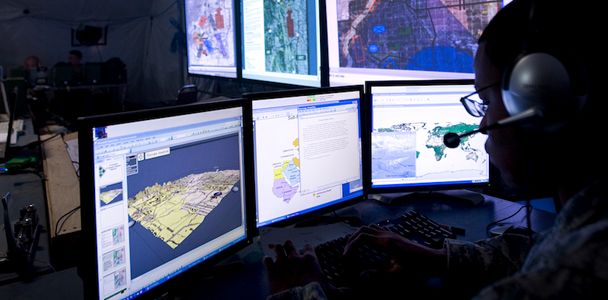Participants within the U.S. defense geospatial products market have reached a point in which each has established their particular niche. The transformation into a tools and services market has begun, as companies develop applications that can enhance and integrate vast amounts of information on to geographic canvases.
The advent of “big data” (geospatial data so large and complex it becomes difficult to process) is a driving force behind initiatives focused on managing new data formats, such as full motion video, high-definition and 3-D graphics.
New research from Frost & Sullivan finds that Department of Defense (DoD) spending on geospatial products and research is estimated to reach $3.21 billion by 2017. This amount would be significantly higher if classified spending were publicly accessible for reporting.
The volume of data being gathered for intelligence, surveillance and reconnaissance (ISR) has become unmanageable. The number of sensors deployed on the ground, unmanned aerial vehicles (UAVs) and satellites continues to soar, as does the ability to keep collection assets in place for longer periods of time. As improvements to systems create the ability to generate even larger volumes of data, U.S. DoD planners are struggling to create methods to ensure that the data collected is useful for warfighters.
“ISR systems supporting operations in Afghanistan are reported to gather over 53 terabytes of data daily,” said Aerospace & Defense Senior Industry Analyst John Hernandez. “This is a significant increase from the start of the war in this country, in which a single terabyte of information was considered a large volume of data.”
In order to meet the challenge of processing and taking advantage of the amounts of geospatial data generated, a mechanism is required that can automatically sort data to the proper users. On the other hand, geospatial data requires exploitation by qualified intelligence analysts that are being inundated with large quantities of raw data. The Defense Advanced Research Projects Agency (DARPA) is developing technologies that will automate and streamline some initial analysis functions to speed up the exploitation process.
The essential value of current imagery, full-motion-video and terrain data continues to generate dependency on geospatial tools and services. In addition to the obvious intelligence value of near-real-time geospatial products and services, the ability to have similar access in the event of national emergencies or natural disasters is invaluable. Geospatial intelligence (GEOINT) can also collect what is sometimes referred to as “nontraditional data.” For example, the amount of cultivated land in a certain area may indicate increased stability. These assets can provide valuable information that provides a better understanding of the adversary and operational environment.
Analysis of U.S. Defense Geospatial Markets is part of the Aerospace & Defense Growth Partnership Services program, which provides global Mega Trends, information on emerging markets and the latest technology innovations, market, economic, customer, competitive, and best practices research.










